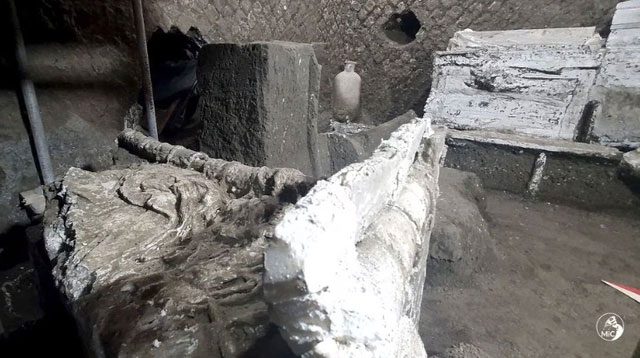Archaeologists have recently discovered a small bedroom in a Roman villa near Pompeii, which was almost certainly used by slaves.
This information was announced by the local Ministry of Culture on Sunday. Accordingly, this discovery sheds light on the lowly status of slaves in the ancient world.
According to reports, the room was found at the Civita Giuliana villa, located about 600 meters north of the walls of Pompeii, which was obliterated by a volcanic eruption from Mount Vesuvius nearly 2,000 years ago.
Inside the room, two beds were discovered, only one of which had a mattress, along with two small cabinets and a variety of ceramic jars and containers, in which the remains of two mice and a rat were found.

This image illustrates the precarious conditions and poor hygiene that the lower classes lived in during that time. (Illustrative photo: Reuters).
The Ministry of Culture stated in its announcement: “These details once again highlight the precarious conditions and poor hygiene that the lower classes lived in during that time.”
Materials such as furniture and textiles in the room were covered by the devastating eruption of rocks, gas, and ash from Vesuvius, which decomposed over the years, leaving voids in the debris found. When filled with plaster, these voids revealed the original shapes and outlines of the long-used materials, including the contours of a crumpled blanket still resting on the bed frame.
“It looks like a photograph… However, this is an image from nearly 2,000 years ago,” the Ministry stated.
In the condition found, archaeologists did not discover any traces of nets, locks, or chains to restrict the slaves living in the room.
Gabriel Zuchtriegel, the director of the Archaeological Park of Pompeii, stated: “It seems that control was primarily exercised through internal slave organization rather than physical barriers and restraints.”
Excavations at the Civita Giuliana villa were first conducted in 1907-1908 and were revisited in 2017 when authorities realized the site was being looted by illegal diggers. Archaeologists noted that part of one of the beds had been destroyed by a tunnel used by the thieves to access another part of the villa.
Pompeii and the surrounding countryside were buried under volcanic ash when Mount Vesuvius erupted in 79 AD, killing thousands of Romans who were unaware that they were living beneath one of the largest volcanoes in Europe. The eruption buried the city under a thick layer of ash, preserving many residents and buildings.
This site has witnessed a surge in archaeological activity recently, aimed at preventing decay and neglect over the years, largely thanks to a newly concluded EU-funded project worth 105 million euros.
Culture Minister Gennaro Sangiuliano stated on Sunday that conservation and research efforts will continue. He said: “What we are learning about the material conditions and social organization of that era opens new horizons for historical and archaeological studies.”


















































